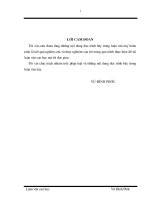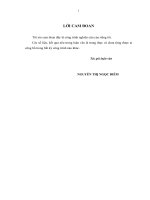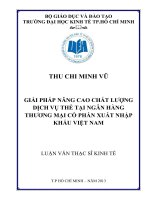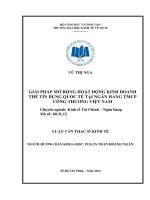(Luận văn thạc sĩ) impacts of interpersonal conflict and occupational stress on the organizational commitment of vietnamese employees, and the role of social support
Bạn đang xem bản rút gọn của tài liệu. Xem và tải ngay bản đầy đủ của tài liệu tại đây (2 MB, 126 trang )
VIETNAM NATIONAL UNIVERSITY, HANOI
VIETNAM JAPAN UNIVERSITY
-------------------------
NGUYEN QUANG MINH
IMPACTS OF INTERPERSONAL CONFLICT
AND OCCUPATIONAL STRESS ON THE
ORGANIZATIONAL COMMITMENT OF
VIETNAMESE EMPLOYEES,
AND THE ROLE OF SOCIAL SUPPORT
MASTER’S THESIS
BUSINESS ADMINISTRATION
Hanoi, 2020
VIETNAM NATIONAL UNIVERSITY, HANOI
VIETNAM JAPAN UNIVERSITY
--------------------------------
NGUYEN QUANG MINH
IMPACTS OF INTERPERSONAL CONFLICT
AND OCCUPATIONAL STRESS ON THE
ORGANIZATIONAL COMMITMENT OF
VIETNAMESE EMPLOYEES,
AND THE ROLE OF SOCIAL SUPPORT
MAJOR: BUSINESS ADMINISTRATION
CODE: 8340101.01
RESEARCH SUPERVISORS:
Prof. Dr. MOTONARI TANABU
Assoc.Prof. Dr. NHAM PHONG TUAN
Hanoi, 2020
ACKNOWLEDGEMENT
In this part, I would like to express my deepest gratitude and massive thanks to
my supervisors Prof. Motonari Tanabu and Assoc.Prof. Nham Phong Tuan. With your
support, guidance, comments, recommendations and encouragements, I have already
overcome troubles in doing the master thesis and finally completed it.
I would like to share my thanks to all of respondents who helped me accomplish
the thesis with your provided data. I also want to send my big thanks to Huong-san, an
assistant of MBA Programs and all member of MBA-03 class. Thank to them, I have
the memorable and meaningful time in Vietnam Japan University in two years and I
will never forget it.
Thank you Viet Nam Japan University for supporting me a lot as well as giving
me an memorable opportunity to experience the academic environment that I could
gain beneficial knowledge and assist me in expanding my perspective in life.
Thank you so much for everything. For me, that was unforgettable time in my
life and also the great motivation and inspiration for me to improve myself in the future.
Nguyen Quang Minh
11/5/2020
ABSTRACT
Purpuse of the study: In the real time, the working context in Vietnam is recognized
with the high level of competitive pace, so the ratio of workers rotation is a crucial
point for the development of busisses. As a result, many Vietnamese employees have a
sense of changing their works because they tend to seek for the better working
environment in the new places where they can be treated with full of respective. This is
a noticeable issue because it places a crucial task for Human Resource Managers in
controlling and managing the labour of the company. My research concentrates on two
main parts that have already occured in the working environmenet in Vietnam. The
first problem links to the impacts from interpersonal conflict with both supervisors and
coworkers on the commitment behaviors of Vietnamese employees. In the second part,
the issue of social support that employees can gain from outside of the company will
decides the level of organizational commitment of them. Besides, the factor
occupational stress will also interfere in this relationship with the specific role as a
mediator. Within this relationship between three factors, the study contribute exams the
effect from social support on engagement attitude of Vietnamese workers in both direct
and indirect effect.
Research Methodology/Design: The research will be implemented through 217
responses of employees who are working in Vietnam. After collecting data from
respondents, the next process will be using the SPSS tool for the analyzing step.
Findings: Conflict with supervisors is the important point to decide commitment
behavior of Vietnamese employees, but the conflict with colleagues seems to increase a
weak significant on their commitment. Besides, Social Support will strongly contribute
for the organizational commitment behavior, but it is lower when stress at work
interferes. Stress also has the weak positive effect with social support and commitment,
and takes a role as mediator when receiving the effect from social support on the side
of family.
Research Limitations: The way that employees produce the weak positive effect from
their conflict with coworkers to their commitment behavior has not been clear with its
reasons. Another limitaition is the size of social support is only narrowed in the scale
from Family and Friends. And the final limitation is there is a shortage of
determination about the positive impact from Stress at work with social support and
organizational commitment.
Contribution: Explore the factors affecting on Vietnamese workers‟ commitment
behavior.
Keyword: interpersonal conflict, social support, occupational stress, organizational
commitment.
TABLE OF CONTENTS
CHAPTER 1. INTRODUCTION ....................................................................................... 1
1.1 Background of the Study ........................................................................................... 1
1.1.1 Practical Issues .................................................................................................... 2
1.1.2 Theoretical Issues ................................................................................................ 4
1.2 Research Objective and Research Questions............................................................. 7
1.3 Subject and Scope of the Study ................................................................................. 7
1.4 Outline of the Thesis .................................................................................................. 8
CHAPTER 2. LITERATURE REVIEW AND HYPOTHESES DEVELOPMENT ......... 9
2.1 Review of Conceptual Framework and Literature Background ................................ 9
2.1.1 Interpersonal Conflict .......................................................................................... 9
2.1.2 Social Support ................................................................................................... 16
2.1.3 Occupational Stress ........................................................................................... 20
2.1.4 Organizational Commitment ............................................................................. 24
2.2 Review of Relevant Theoretical Model ................................................................... 26
2.3 Hypotheses Development and Conceptual Model................................................... 30
2.3.1 Interpersonal Conflict with Supervisors and Organizational Commitment ...... 31
2.3.2 Interpersonal Conflict with Colleagues and Organizational Commitment ....... 31
2.3.3 Social Support and Occupational Stress ........................................................... 32
2.3.4 Occupational Stress and Organizational Commitment ..................................... 33
2.3.5 Social Support and Organizational Commitment ............................................. 34
2.3.6 Interpersonal Conflict with Supervisors and Occupational Stress .................... 34
2.3.7 Interpersonal Conflict with Colleagues and Occupational Stress ..................... 35
CHAPTER 3. RESEARCH METHODOLOGY .............................................................. 39
3.1 Sampling .................................................................................................................. 39
3.2 Data Collection Procedures ..................................................................................... 40
3.3 Data Analysis ........................................................................................................... 41
3.4 Measurements .......................................................................................................... 41
3.5 The Development Processs of the Questionnaire .................................................... 42
CHAPTER 4. RESEARCH ANALYSIS AND RESULTS .............................................. 44
4.1 Demographic Analysis............................................................................................. 45
4.1.1 Frequency Analysis ........................................................................................... 45
4.1.2 Descriptive Analysis ......................................................................................... 47
4.1.3 Reliability and EFA Analysis ............................................................................ 51
i
4.2 Analyzing results of the relationship between “Interpersonal Conflict” and
“Organizational Commitment” ...................................................................................... 64
4.3 Analyzing results of the relationship between “Interpersonal Conflict” and
“Occupational Stress” .................................................................................................... 68
4.4 Analyzing results of the relationship between “Social Support”, “Occupational
Stress” and “Organizational Commitment” ................................................................... 72
4.4.1 The result of the relationship among Social Support from Family,
Occupational Stress and Organizational Commitment .............................................. 72
4.4.2 Analyzing the relationship among Social Support from Friends, Occupational
Stress and Organizational Commitment ..................................................................... 76
4.5 Hypotheses Testing .................................................................................................. 79
4.6 The comparison of the research result between Robert Bosch Corporation and
VietAbank. ..................................................................................................................... 80
4.6.1 Robert Bosch Gmbh Company ......................................................................... 80
4.6.2 VietAbank Company ......................................................................................... 82
CHAPTER 5: DISCUSSIONS, IMPLICATIONS AND LIMITATIONS OF THE
STUDY.............................................................................................................................. 84
5.1 Discussions of the Study .......................................................................................... 84
5.1.1 The relationship between “Interpersonal Conflict” and “Organizational
Commitment” ............................................................................................................. 84
5.1.2 The relationship between “Interpersonal Conflict” and “Occupational Stress” 87
5.1.3. The result of the relationship between “Social Support”, “Occupational
Stress” and “Organizational Commitment” ............................................................... 88
5.1.4 The difference in these relationships between Robert Borsch Corporation and
VietAbank .................................................................................................................. 91
5.2 Implications of the Study ......................................................................................... 93
5.3 Limitations of the Study .......................................................................................... 96
CONCLUSION ................................................................................................................. 99
REFERENCE .................................................................................................................. 101
APENDIX
ii
LIST OF TABLES
Table 2.1 The general definition of Interpersonal Conflict types in an organization .... 10
Table 2.2 The reviewed instruments for measuring Interpersonal Conflict .................. 14
Table 2.3 All items of the measured instruments for Interpersonal Conflict with
Supervisors and Colleagues ((Spector & Jex, 1998) (Belausteguigoitia et al., 2016) ... 15
Table 2.4 The reviewed instruments for measuring Social Support .............................. 18
Table 2.5 All items of the MSPSS instruments for measuring Social Support (Zimet et
al., 1988) ......................................................................................................................... 20
Table 2.6 All items of the measured instrument for Occupational Stress (Cullen et al.,
1985)............................................................................................................................... 23
Table 2.7 All items of the measured instrument for Organizational Commitment (Allen
& Meyer, 1990) .............................................................................................................. 26
Table 3.1 Measured Instruments of all related variables in the study ........................... 42
Table 4.1.1 The Frequency Statistics Table ................................................................... 45
Table 4.1.2 The table of Frequency Analysis for Age, Gender and Education Level ... 46
Table 4.1.3 The codes of relevant variables ................................................................... 48
Table 4.1.4 The descriptive statistics table of “Interpersonal Conflict with Supervisors
........................................................................................................................................ 48
Table 4.1.5 The descriptive statistics table of “Interpersonal Conflict with Colleagues
........................................................................................................................................ 49
Table 4.1.6 The descriptive statistics table of Social Support ....................................... 49
Table 4.1.7 The descriptive statistics table of Occupatoinal Stress ............................... 50
Table 4.1.8 The descriptive statistics table of Organizational Commitment ................. 51
Table 4.1.9 The Reliability Table of Interpersonal Conflict with Supervisors .............. 52
Table 4.1.10 The table of EFA Analyzing for Interpersonal Conflict with Supervisors
........................................................................................................................................ 53
Table 4.1.11 The Reliability Table of Interpersonal Conflict with Colleagues ............. 54
Table 4.1.12 The table of EFA Analyzing for Interpersonal Conflict with Colleagues 54
Table 4.1.13 The Reliability Table of Social Support ................................................... 56
Table 4.1.14 KMO and Barlett‟s Test, and Total Variance tables of Social Support .... 57
Table 4.1.15 The table of Rotated Component Matrix for Social Support before
removing items ............................................................................................................... 57
iii
Table 4.1.16 The table of Rotated Component Matrix for Social Support after
removing items ............................................................................................................... 58
Table 4.1.17 The Reliability Table of Occupational Stress ........................................... 59
Table 4.1.18 The table of EFA Analyzing for Occupational Stress .............................. 60
Table 4.1.19 The Reliability Table of Organizational Commitment ............................. 62
Table 4.1.20 The table of EFA Analyzing for Organizational Commitment ................ 63
Table 4.2.1 The correlations table of three variables ICC, ICS and OC........................ 65
Table 4.2.2 The results of Regression Analysis for ICS, ICC and OC .......................... 67
Table 4.3.1 The correlations table of Interpersonal Conflict and Occupational Stress . 69
Table 4.3.2 The regression analysis table of Interpersonal Conflict and Occupational
Stress .............................................................................................................................. 70
Table 4.4.1 The outcome variables of the mediator relationship (with Social Support
from Family) .................................................................................................................. 73
Table 4.4.2 The description of effect of Social Support from Family on Organizational
Commitment ................................................................................................................... 75
Table 4.4.3 The outcome variables of the mediator relationship (with Social Support
from Friends) .................................................................................................................. 77
Table 4.4.4 The description of effect of Social Support from Friends on Organizational
Commitment ................................................................................................................... 78
iv
LIST OF FIGURES
Figure 2.1 The conceptual model of the effect of Interpersonal Conflict on
Organizational Commitment (Imanol Belausteguigoitia et al., 2016) ........................... 27
Figure 2.2 The general view of the Interpersonal Conflict‟s impacts (Frone, 2000) .... 28
Figure 2.3 The Model of the relationship between Interpersonal Conflict and Job Stress
(Haq, 2011) .................................................................................................................... 29
Figure 2.4 The conceptual research model of the study ................................................ 37
Figure 4.1 The results of impacts from Interpersonal Conflict on Occupational Stress 71
Figure 4.2 The effect of mediation relationship between Social Support from Family,
Occupational Stress and Organizational Commitment .................................................. 76
Figure 4.3 The resuts of all variables in Robert Bosch Company ................................. 81
Figure 4.4 The resuts of all variables in VietAbank Company...................................... 82
Figure 5.1 The research model with final results ........................................................... 91
v
LIST OF ABBREVIATIONS
ICS
ICC
OS
OC
SS
Interpersonal Conflict with Supervisors
Interpersonal Conflict with Colleagues
Occupational Stress
Organizational Commitment
Social Support
vi
CHAPTER 1. INTRODUCTION
1.1 Background of the Study
Observing deeper into Vietnam‟s society today, it is evident that Vietnam is a
developing country with a high growth rate in the world. The development of Vietnam
can be observed in many industries and fields of various activities. Along with this
development, we can notice that Vietnam is also gradually expanding international
cooperation with other territories around the world. An example of Vietnam's
internationalization can be found through some typical cooperation agreements such as
Free Trade Agreement (FTA), Association of Southeast Asian Nations (ASEAN) or
Trans-Pacific Partnership Agreement (TPP) (General Statisitc Office of Vietnam,
2019). Based on those international agreements, Vietnam is standing chances to
cooperate with many other areas around the world.
Having the opportunity to develop based on the current situation of
internationalization, it is indispensable for many Vietnamese businesses to emerge,
including domestic enterprises, startups, and international joint venture enterprises.
This has made Vietnam become an ideal business environment with a high pace of
dynamic and competitiveness.
Based on the data from the General Statistics Office of Vietnam in 2018, the
population of Vietnam is roughly 94.6 million that proves Vietnam is a relatively
populous country in the world. Thank the high population, combining with the strong
pace of internationalization, there are many domestic and international corporations
that have been formed and hold many opportunities to take advantage of the potential
factor as a human resource in Vietnam.
For Vietnamese companies, they will have the opportunity to recruit potential
workers and turn around human resources so as to create the highest value for their
1
businesses. As for foreign businesses, in addition to capturing high-quality human
resources in Vietnam, they also focus on hiring Vietnamese laborers with their low
budget, which helps a lot in cost savings and increases business growth. Facing many
opportunities, companies operating in Vietnam will always focus on the quality of their
human resources and also have their own policies to attract workers from one place to
another. Besides the relatively competitive market economy in Vietnam, the rotation of
resources is stronger and the impact of businesses on employees will have a great
impact within only by the smallest policies or decisions.
In contrast, for the Vietnamese workers, because the competitiveness between
businesses is very large, they will have a lot of chances to see themselves in the
business, assess it and select the suitable places for them to continue their careers.
Consequently, in the scope of the study, I want to focus deeply on the aspect of
organizational behaviors of employees in Vietnam, specifically the organizational
commitment issue of Vietnamese employees in the current social context. From the
study of Organizational Commitment, I hope that my contributions to this research will
be beneficial for Vietnamese businesses in understanding its employees, as well as
giving an overview of factors influencing the "Organizational Commitment". In the
near future, the research can also assist businesses in retaining their human resources
during the current development period.
As I mentioned about Organizational Commitment, this is a backlog issue in
Vietnamese businesses. Therefore, to get specific evidence on this issue, I want to
present specific shreds of evidence of Organizational Commitment in both the
“Practical Issues” and "Theoretical Issues".
1.1.1 Practical Issues
In the current context, there is an emergent issue in Vietnam is the increasing
rate of employee turnover. In general, the problem of leaving employees so far is very
2
common and based on many different factors leading to the employee's quitting
decision. Once the employee resignation issue is raised, we need to ask a question that
"What has affected the employee's commitment to the organization" when making this
decision.
To put this issue in Vietnam society, a reality that can be seen in the corporate
environment is that the commitment to the organization in the workplace environment
in Vietnam is rapidly declining.
This issue is currently concerned and much evidence has proved this fact.
Researching on this issue, Anphabet, a pioneer company in Vietnam for a
comprehensive employer brand solution, conducted a research on the job market,
namely by conducting surveys of up to 75,418 employees. The result was that they
measured the employee turnover rates in Vietnam in 2017 and 2018 at 16% and 20%
respectively, and Anphabe also forecasts this figure could reach 22% in 2019 (Anphabe,
2018), and this figure will gradually increase from the year 2020. Due to the
concentration of internationalization with a high level of competitiveness, the level of
turnover is also high and it causes a huge loss for the company in terms of Human
Resources. For example, it makes the recruitment for replacement can account for 1520% salary of a year, or the compensation is higher if the quitter is the excellent
employees because of the loss of knowledge, relationships and training costs.
This is a heated topic and many authors have been focusing on this issue.
Therefore, many authors stand on the manager's perspective and see this as a part of
Human Resource Management. Under the perspective of a researcher, I would like to
make this issue more obvious and contribute to conflict management for companies.
In addition to the figures that Alphabe has researched on employee turnover
rates in Vietnam, some of the other sources also prove this alarming fact.
3
In the report of Navigos Search, the retail sector faced a high rate of turnover.
Specifically, 28% of employees lack their commitment to the organization, 49% of
employees feel vulnerable to being approached by companies in the same industry and
60% of employees think their average tenure with their job is only 2 to 3 years
(Navigos Group, 2018). In the 2016 survey report of Talentnet and Mercer, besides
Retail with a high rate of turnover (39.2%), other fields also recognize these issues
such as Medicine (17%), Technology (16.2%).
Through the data that organizations have researched on the labor market in
Vietnam, it can be realized that the lack of engagement to enterprises and the high rate
of leaving become more common, especially in specific industries.
1.1.2 Theoretical Issues
Facing organizational commitment issue, this can be considered as a relatively
common problem in many countries around the world, not only existing in Vietnam.
Studying on this issue, Turunen (2014) concludes that commitment to an organization
is a crucial issue and this affects many related fields as well as the market of human
resources.
In addition to the perspectives on the role of organizational commitment,
organizational commitment affects employees, who tend to be more satisfied with their
work and reduce the risk of leaving the organization if containing a high level of
commitment. Consequently, two elements deciding the success of an organization are
Organizational Commitment and Job Satisfaction (Mathur & Salunke, 2013). Besides,
Organizational Commitment has the profound impact on Knowledge Management in
both direct and indirect ways (Rocha et al., 2008) accompanying with the implication
to employees‟ Job Performance (Rafiei et al., 2014).
Normally, studying the responsibility of organizational commitment, the authors
often focus on measuring the low or high level of commitment behavior (Meyer &
4
Allen, 1984). With high organizational commitment, the employee can enhance the
quality of working pracice and working capacity (Arthur, 1994), besides commitment
of work with low pace places several negative consequences relating to leaving the job
and behavior of defection (Blau & Boal, 1987).
The role of Organizational Commitment is very significant for the development
of the business. However, achieving the commitment of employees in the company is a
challenge because there are always many factors involved in the commitment
behaviors of workers. Jawaad et al (2019) toward the Human Resource Management
sector, the organizational behaviors embedded in the influence of factors such as
enrolling, workplace concern, job estimation, rewards and acceptance, and instruction
process.
Relating to this aspect, many authors also focus on studying the relationship
between working pleasure and company engagement behavior, specifically through
career development, pride at work, or emolument payment (Ali et al., 2014).
According to Allen and Meyer (1990), Organizational Commitment is measured
based on the nonphysical situations of attitude and thoughts toward the organization.
Therefore, the working place is a business environment where the linking between
employees and their executives, or even coworkers is obvious (Subramanian, 2017). In
this relationship among people, the interpersonal relationships will bring the
connection to individual behaviors (Frone, 2000), and one of the main factors existing
among them is called “Interpersonal Conflict”.
Besides the factors mentioned above, within the scope of the study, it is
essential to concentrate on the "Interpersonal Conflict" having impacts on
Organizational Commitment, as this factor will be related to the result of individual
study of mental process (Frone, 2000). In the aspect of Human Resouce Management,
workplace conflict at the workplace stems from many diverse factors such as salary,
5
appraisals, psychological motivation, or working environment, in addition to employee
conflict at work often. Moreover, Interpersonal Conflict is recognized by the roots
from the distinction in different identiy and consciousness of life values (Isa, 2015).
When employees have a conflict with each other, its impact on the business is
utterly clear, as the implications to firm operation which including cliens, workers,
financial issues, or internal system (Eunice et al., 2015) and conflict can also mitigate
the efficiency of company operation leading to reduced capacity (Omisore & Abiodun,
2014).
The consequences of Interpersonal Conflict can also be recognized in both
misconduct and hatred attitude (Bibi et al., 2012). Interpersonal Conflict can also relate
to engagement practice of employees (Belausteguigoitia et al., 2016), and dominates
the quality of managerial arrangement besides the pride at work and commitment
attitude (Medina et al., 2005). In the company, Interpersonal Conflict has been divided
into 2 dimensions when moving to both bosses and coworker and releases different
outcomes, which include the implications of commitment demeanour (Frone, 2000).
Relating to the factors that influence organizational commitment, within this
study, I also focus on the social aspects of an individual. Specifically, the level of
commitment to an organization is maintained or not only based on the effects of stress
at work, as well as social support from society, also known as Social Support.
The main plan of the study will aim to two parts. The first part is investigating
more clearly the implications of interpersonal conflict towards the organizational
commitment of Vietnamese employees. Another part is clarifying directly the impacts
of Social Support to Organizational Commitment, but the Occupational Stress factor,
also known as workplace stress, will act as the mediator, which is affected by social
support before indirectly influencing the commitment behaviors of Vietnamese
workers.
6
1.2 Research Objective and Research Questions
- Research Objectives: Investigating the impacts of Interpersonal Conflict,
Occupational Stress, and Social Support on the Organizational Commitment of
Vietnamese employees. Meanwhile, the Occupational Stress takes the role of mediator,
affected by Social Support and mediated the relationship between Social Support and
Organizational Commitment.
- Research Questions:
Q1: How does Interpersonal Conflict with Supervisors impact on Organizational
Commitment of Vietnamese employees?
Q2: How does Interpersonal Conflict with Colleagues impact on Organizational
Commitment of Vietnamese employees?
Q3: How does Occupational Stress impact on Organizational Commitment of
Vietnamese employees?
Q4: How does Social Support impact on Organizational Commitment of Vietnamese
employees?
Q5: How does Social Support affect Occupational Stress of Vietnamese employees?
1.3 Subject and Scope of the Study
- The subject of the study will be the Vietnamese employees working in Vietnamese
companies in a different type of job. However, the number of companies they are
working will be narrow in only 3 in this study, and they are in a similar field.
- The Scope of the Study: The research is conducted in Vietnam and the data collection
time for this study from 5th April, 2020 to 15th April, 2020. All respondents in this
research are Vietnamese and they are working in Vietnam companies.
7
1.4 Outline of the Thesis
Besides the parts of abstract, research content, reference, and appendix, the
study includes five chapters as below.
Chapter 1: Introduction: Mentioning the background of the research including both
practice issue and theoretical issue; research objective and research questions; subject
and scope of the study; and thesis outline.
Chapter 2: Literature Review and Hypothesis development: introducing the literature
of former authors about “Interpersonal Conflict”, “Social Support”, “Occupational
Stress”, and “Organizational Commitment.
Chapter 3: Research Methodology: Describing the method of collecting data,
analyzing and forming the final results.
Chapter 4: Research Analyzing and Results: Based on the data collected, the study
will extend to analyzing by using SPSS. The final results will be displayed as the
frequency, descriptive, correlation, and regression before concluding the relevant
information to the study.
Chapter 5: Recommendation, Solution and Conclusion: After analyzing the final
results, there are recommendations and solutions for the issues relating to interpersonal
conflict, social support, and occupational stress that having effect on Organizational
Commitment. This is based on the author knowledge and could improve the
organizational performance in reality.
8
CHAPTER 2. LITERATURE REVIEW AND HYPOTHESES
DEVELOPMENT
2.1 Review of Conceptual Framework and Literature Background
In this chapter, the literature of the terms “Interpersonal Conflict”, “Social
Support”, “Occupational Stress”, and “Organizational Commitment” will be presented
and made clear when being used in this study.
2.1.1 Interpersonal Conflict
2.1.1.1 Interpersonal Conflict Definitions
Before going into the "Interpersonal Conflict", it is necessary to understand the
previous studies of "Conflict", which appeared in many the literature reviews by
different authors.
Presently, there are many various definitions of "Conflict", Omisore and
Abiodun (2014) cited that the ideal way to understand Conflict's definition should be
divided into three distinct approaches: a functional approach, situational approach, and
interactive approach. As a result, in order to grasp the definition of conflict, we can
rely on the definition in three kinds of approaching.
In the book “Conflict resolved? A Critical Assessment of Conflict Resolution”
(Tidwell, 2001), as for the definition of conflict by author George Simmel in 1955, he
pointeds “conflict acts as the method with tackling divergent dualism to archive the
unity, even it may eliminate the benefit from another conflict parties”. Meanwhile,
following the situation approach, the book also mentioned the conflict based on
Bercovitch‟s definition in 1984 as “a situation creates the unbreakable aims and
values among various parties”. Finally, according to the interactive approach, conflict
was compared with “the interaction among people who has the dependent on each
other, and perceives the inappropriate purposes and the intervention from each other
9
to attain these targets” in the conclusion of the author Folger in 1993. According to
Thakore (2013), conflict is explained as the antipathy between two people or many
different individual or even various teams when they have effort to archive the
agreement from the opposition sides.
The object of this study is to target conflicts that occur within an enterprise.
Conflict happens among individuals and group, specifically some people of one group
interact with others in different groups, or it can also occur inside a specific group
(Nicholson, 2009). Based on the motivation on the interpersonal conflict that happens
inside employees and has a significant effect on their commitment to companies, there
are several former researches focusing on this issue in the past.
Going deeply into conflict in the organization, in the book “Organizational
Behavior: Integrating Individuals, Groups, and Organizations” published in 2016, the
author Champoux pointed out that the conflict in the organization can be determined
under six levels and various forms.
Table 2.1 The general definition of Interpersonal Conflict types in an organization
Levels of
Definition of Conflicts’ Forms
Conflicts
This occurs among individual, in particular, this conflict comes from
Intrapersonal
threatening to a fundamental value of an individual, or the feeling
Conflict
that they are not treated fairly in the team, or other conflicts in terms
of socialization.
A form of conflict existing in the relationship between two
Interpersonal
conflict
individuals, or among many people. Interpersonal Conflict is the
basic contradictory behavior of an organization, and it can be derived
from Intrapersonal Conflict. An individual may have discomfort
inside as Intrapersonal Conflict and explode to other members of the
10
organization, as Interpersonal Conflict.
Intragroup
Conflict
Inter-Group
Conflict
Conflict existing among representatives in a specific team. These
conflicts may occur during the work process to achieve the
organization's overall goals.
Conflict happens between two or more groups within an
organization.
Include all conflicts occurring within an organization. These conflicts
Intra-
can be seen both vertically and horizontally within an organization.
Organization
The vertical level can be between managers and subordinates, while
Conflict
the horizontal level is among individuals, departments with working
groups.
Inter-
Conflict happens between two or more organizations, most of these
Organization
kinds of conflict result from the relationship between different
Conflict
organizations.
Regarding the division of types of conflict, according to Simons and Peterson
(2000), they researched the existence of two distinct types of conflict: Task Conflict
and Relationship Conflict. Specifically, with the definition of each type of conflict, the
author Jehn (1995) clearly distinguished these two types as follows:
- Task Conflict: It is considered as the awareness of disagreements about ideas,
viewpoints, and opinions among the members in the decision making process when
working together and this causes a divergence between them.
- Relationship Conflict: Also known as an emotional conflict. This type of conflict
occurs between individuals, rooted on the contrary of personalities. This leads to the
employees feel uncomfortable, creating large pressure on each other at work.
11
Expanding on other types of Conflict, Fisher (2006) defined another three kinds
of conflict with the larger scale:
- Economic Conflict: This type of conflict relates to the economic aspect, in which two
conflicting parties are seeking for maximizing what they can implement to achieve
economic goals. Usually, these two sides of the conflict will not have mutual goals.
- Value Conflict: The difference occurs in the principles and practices in life. Typically,
this type of conflict comes from the difference between individuals in factors related to
culture, lifestyle, morality, religion, or politics.
- Power Conflict: A conflict related to the attainment of a power element among
relevant parties. Each part always looks for achieving and maintains maximum power,
and this will directly affect the other one.
When placing conflict factor within the business area, many authors have
assessed the negative impact of conflict, but several authors still emphasized the
beneficial effect that conflict can bring to enterprises, especially the positive impacts
viewed at Task Conflict at both individual level (Baron, 1991) and the group level (Fiol,
1994).
Although the elements of conflict come from various sources and approaches in
this study, the influence of Interpersonal Conflict on Organizational Commitment will
be measured. Besides implications of conflicts to specific benefits like salary or labour
wages (Isa, 2015), the study only focus Interpersonal Conflict on the emotional
behavior, which exists inside employees and that is indispensable at organization‟s life
(Kumar et al., 2018). In addition to the implications of Interpersonal Conflict, many
authors aim to study, for example, its impact on individual aberrance and
organizational deviation, or even leaving purpose, (Haq, 2011).
12
2.1.1.2 Interpersonal Conflict Measured Instruments
When the relationship between interpersonal conflict and organizational
commitment is determined, analyzing the objects which were targeted in the
interpersonal conflict variable including interpersonal conflict with colleagues
(horizontal level) and interpersonal conflict with supervisors (vertical level). The next
step to facilitate the measurement and evaluation of these two levels of interpersonal
conflict is to find the specific scales for them. The scales with defined items were
found, so I split the scale separately to evaluate these 2 levels.
Briefly, to evaluate Interpersonal Conflict in the research, I summarized the
assessments from various authors within specific dimensions.
13
Table 2.2 The reviewed instruments for measuring Interpersonal Conflict
Interpersonal
Conflict at Work
Scale (ICAWS)
(Spector & Jex,
1998)
Anxiety
Interpersonal
Conflict Scales
(Imanol
Belausteguigoitia,
2016)
Agression
Workplace
Interpersonal
Conflict Scale
(WICS) (Wright,
et al., 2017)
Unfair Treatment
Interpersonal
Conflict in the
Workplace
(ICW) (Schieman
& Reid, 2008)
Altercation
Depression
Tension
Rudeness
Violation
Frustration
Interaction
Irrresponsibility
Injustice
Incompetence
Inequity
Work Disagreement
Unfairness
Thwarted aims
Incompetence
Physical
antagonism
Personal‟s Verbal
Agression
The instruments above are used to evaluate Interpersonal Conflict in an
organization with different scales. Within the scope of this paper, ICAWS
(Interpersonal Conflict at Work Scale) (Spector & Jex, 1998) and measurement
performance of author Belausteguigoitia et al., (2016) are appropriate compared to the
remaining ones, so these two instruments will be used to assess the Interpersonal
Conflict variable.
For the evaluation of Interpersonal Conflict with Colleagues, the scale was used
with 4 items to assess the level of employees having a conflict with their colleagues
(Belausteguigoitia et al., 2016). For instance, in this instrument, some of the questions
target tension among employees as “My colleagues and I often get angry while
14









